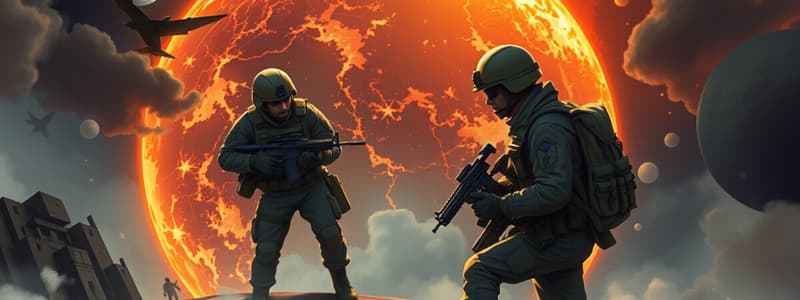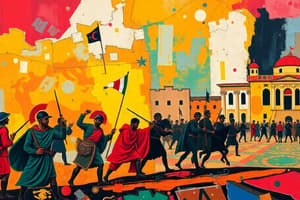Podcast
Questions and Answers
What is a problem?
What is a problem?
An issue or obstacle that makes it difficult to achieve a desired goal or end state.
What are well-structured problems?
What are well-structured problems?
Easy to identify, required information is available, and methods to solve them are somewhat obvious.
How are medium-structured problems characterized?
How are medium-structured problems characterized?
More interactively complex than well-structured problems.
What defines ill-structured problems?
What defines ill-structured problems?
Problem solving is a form of what?
Problem solving is a form of what?
What two terms are often associated with problem solving?
What two terms are often associated with problem solving?
What are the 7 steps of the Army's approach to problem solving?
What are the 7 steps of the Army's approach to problem solving?
Gathering information and knowledge requires ______ and ______ to solve problems.
Gathering information and knowledge requires ______ and ______ to solve problems.
What are facts?
What are facts?
What is an assumption?
What is an assumption?
What 5 questions must you answer to identify a problem?
What 5 questions must you answer to identify a problem?
What two types of criteria do problem solvers develop?
What two types of criteria do problem solvers develop?
What does screening criteria define?
What does screening criteria define?
What does evaluation criteria do for the problem solver?
What does evaluation criteria do for the problem solver?
Leaders should consider how many solutions to a problem?
Leaders should consider how many solutions to a problem?
What is the basic technique for developing new ideas in a group setting?
What is the basic technique for developing new ideas in a group setting?
What do leaders analyze to determine merits and drawbacks of possible solutions?
What do leaders analyze to determine merits and drawbacks of possible solutions?
Leaders use ___________ and ___________ to analyze possible solutions.
Leaders use ___________ and ___________ to analyze possible solutions.
What does comparing solutions identify?
What does comparing solutions identify?
In formal situations, leaders present their findings and recommendations to the decision maker as what? (Select all that apply)
In formal situations, leaders present their findings and recommendations to the decision maker as what? (Select all that apply)
Every problem requires both a __________ and the ability to _____________ the solution clearly.
Every problem requires both a __________ and the ability to _____________ the solution clearly.
What must be built into the implementation plan?
What must be built into the implementation plan?
Flashcards
Problem
Problem
An issue or obstacle preventing desired results.
Well-structured problem
Well-structured problem
A straightforward problem with clear information and solutions.
Medium-structured problem
Medium-structured problem
More complex than well-structured, requiring more interaction.
Ill-structured problem
Ill-structured problem
Signup and view all the flashcards
Problem Solving
Problem Solving
Signup and view all the flashcards
Decision Making
Decision Making
Signup and view all the flashcards
Critical Reasoning
Critical Reasoning
Signup and view all the flashcards
Creative Thinking
Creative Thinking
Signup and view all the flashcards
Army Problem Solving Steps
Army Problem Solving Steps
Signup and view all the flashcards
Information Gathering
Information Gathering
Signup and view all the flashcards
Fact
Fact
Signup and view all the flashcards
Assumption
Assumption
Signup and view all the flashcards
Identifying Problems
Identifying Problems
Signup and view all the flashcards
Developing Criteria
Developing Criteria
Signup and view all the flashcards
Solutions Consideration
Solutions Consideration
Signup and view all the flashcards
Brainstorming
Brainstorming
Signup and view all the flashcards
Analyzing Solutions
Analyzing Solutions
Signup and view all the flashcards
Comparing Solutions
Comparing Solutions
Signup and view all the flashcards
Presenting Findings
Presenting Findings
Signup and view all the flashcards
Essential Communication
Essential Communication
Signup and view all the flashcards
Implementation Plan
Implementation Plan
Signup and view all the flashcards
Study Notes
Problem Definition
- A problem is an issue or obstacle affecting the achievement of desired goals or end states.
Types of Problems
- Well-structured problems are easily identifiable with readily available information and obvious solutions.
- Medium-structured problems have increased complexity compared to well-structured problems, requiring more intricate interactions.
- Ill-structured problems are the most complex, nonlinear, and dynamic, making them challenging to understand and resolve.
Problem Solving vs. Decision Making
- Problem solving is a form of decision making, which involves selecting a favorable course of action to accomplish a mission.
Related Concepts
- Critical reasoning and creative thinking are closely associated with problem solving.
Army's Problem Solving Steps
- The Army's approach consists of seven steps: gather information and knowledge, identify the problem, develop criteria, generate possible solutions, analyze possible solutions, compare possible solutions, and make and implement the decision.
Information Gathering
- Gathering information requires facts and assumptions to effectively address problems.
Definitions of Facts and Assumptions
- Facts are verifiable pieces of information with objective reality.
- Assumptions are accepted as true without verification due to the absence of facts.
Identifying Problems
- To identify a problem, answering the five Ws: Who, What, When, Where, and Why is essential.
Developing Criteria
- Problem solvers create screening criteria defining acceptable solution limits and evaluation criteria to differentiate between possible solutions.
Solutions Consideration
- Leaders should consider at least two solutions when addressing a problem.
- Brainstorming is the primary technique for developing new ideas in group settings.
Analyzing Solutions
- Each potential solution must be analyzed to assess its merits and drawbacks by using screening criteria and benchmarks.
Comparing Solutions
- Comparing solutions reveals which option best addresses the problem based on the evaluation criteria and employs suitable comparison techniques.
Presenting Findings
- In formal contexts, leaders provide findings and recommendations to decision makers through staff studies, decision papers, or decision briefings.
Essential Communication
- Every problem requires a solution and the ability to communicate that solution clearly.
Implementation Plan Considerations
- A feedback system should be integrated into the implementation plan for timely, accurate information, periodic reviews, and flexibility to adjust as necessary.
Studying That Suits You
Use AI to generate personalized quizzes and flashcards to suit your learning preferences.




